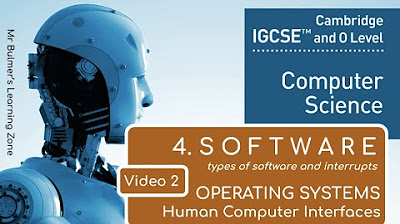HCI 2.7 Human Emotions with Examples | Emotions Recognitions | HCI
Summary
TLDRThis video explores the intricate relationship between human emotions, memory, and human-computer interaction. It delves into different types of human memory, such as short-term, long-term, and sensory memory, and their impact on emotional responses. The script also covers various theories of emotions, how they can be recognized through technology, and their implications for interface design. By understanding the influence of emotions on behavior, designers can create more intuitive and user-friendly systems, enhancing problem-solving, creativity, and overall user experience. The video emphasizes the role of emotional intelligence in developing effective and empathetic technology solutions.
Takeaways
- 😀 Human memory is categorized into short-term, long-term, and sensory memory, each playing a critical role in cognitive processing and learning.
- 😀 Various theories of emotions are discussed, including psychological, cognitive, and biological perspectives on how emotions are recognized and processed.
- 😀 Emotional responses significantly affect human-computer interaction (HCI), influencing usability and user experience.
- 😀 Emotions such as happiness, anger, and surprise can be recognized through speech and facial expressions, impacting how we interact with technology.
- 😀 Positive emotions, like gratitude and euphoria, can increase creativity, problem-solving, and cooperation in HCI contexts.
- 😀 Negative emotions, such as stress and frustration, may reduce cognitive abilities and hinder problem-solving, requiring careful consideration in design.
- 😀 Designing interfaces that respond to emotional states can enhance user experience, especially in challenging or stressful situations.
- 😀 Emotional recognition in technology, such as through voice recognition, is becoming increasingly important for improving personalized user interactions.
- 😀 Positive emotional responses lead to better decision-making and performance, making it essential for interfaces to create a positive emotional impact.
- 😀 Negative emotional responses, like anger or frustration, can decrease performance and create barriers to effective problem-solving in user interfaces.
- 😀 Understanding the relationship between human emotions and cognitive responses helps in designing systems that facilitate smoother, more productive interactions.
Q & A
What are the different types of human memory mentioned in the video?
-The video discusses three main types of human memory: short-term memory, long-term memory, and sensory memory.
How are human emotions related to human-computer interaction (HCI)?
-Human emotions play a significant role in HCI, influencing how users interact with technology. Emotional responses impact the effectiveness of interfaces, as emotions can alter the way information is processed and decisions are made.
What are some general factors affecting human memory?
-General factors that affect human memory include emotional state, the nature of the information being processed, and environmental factors, such as distractions.
What are the different theories of emotions mentioned in the script?
-The script refers to various theories of emotions, including physiological and psychological approaches, though specific theories are not named in detail. It also mentions emotional recognition techniques.
What role does emotional recognition play in HCI design?
-Emotional recognition is crucial in HCI design as it helps create more responsive and empathetic systems. By identifying emotions, interfaces can be tailored to reduce stress, enhance user engagement, and improve problem-solving experiences.
How do positive and negative emotions impact problem-solving?
-Positive emotions tend to enhance creativity and cooperation, while negative emotions can lead to aggression or hinder accurate decision-making. Positive emotions are linked to better problem-solving abilities, while negative ones might create mental blocks.
How can emotional responses influence the design of user interfaces?
-Designing interfaces that recognize and adapt to emotional responses can improve user experiences. For instance, calming designs and rewarding feedback systems can help in stressful situations, whereas complex and challenging tasks might benefit from positive reinforcement.
What is the relationship between human emotions and physical responses?
-Human emotions often trigger physical responses such as increased heart rate, muscle tension, or facial expressions. These reactions are integral to understanding and recognizing emotions, which can influence how individuals interact with technology.
What are the key implications of positive and negative emotions in the workplace?
-Positive emotions in the workplace can increase cooperation, creativity, and accuracy, whereas negative emotions, like stress or aggression, can reduce collaboration and productivity. Managing emotional responses is essential for a healthy work environment.
Why is it important for designers to consider human emotions when developing technology interfaces?
-Designers should consider human emotions to ensure that technology interfaces are user-friendly and adaptive to different emotional states. Emotional awareness can lead to more effective designs that resonate with users, improve their experience, and reduce user frustration.
Outlines

このセクションは有料ユーザー限定です。 アクセスするには、アップグレードをお願いします。
今すぐアップグレードMindmap

このセクションは有料ユーザー限定です。 アクセスするには、アップグレードをお願いします。
今すぐアップグレードKeywords

このセクションは有料ユーザー限定です。 アクセスするには、アップグレードをお願いします。
今すぐアップグレードHighlights

このセクションは有料ユーザー限定です。 アクセスするには、アップグレードをお願いします。
今すぐアップグレードTranscripts

このセクションは有料ユーザー限定です。 アクセスするには、アップグレードをお願いします。
今すぐアップグレード関連動画をさらに表示

HCI 2.8 Human Errors | Types | Sources | Safety with Examples | HCI

HCI 1.5 Component's of Human Computer Interaction with Examples

IGCSE Computer Science 2023-25 - SOFTWARE: Video 2 - THE OPERATING SYSTEM

Natureza e cultura

Video 1 Materi Interaksi Manusia & Komputer Rangkuman 1

HCI 2.1 Input Output Channel in Human Computer Interaction with Examples
5.0 / 5 (0 votes)
